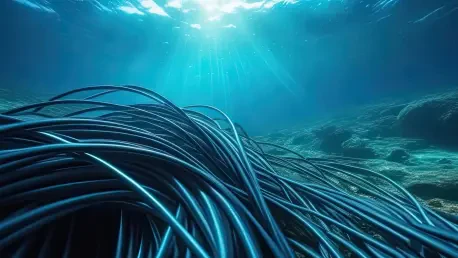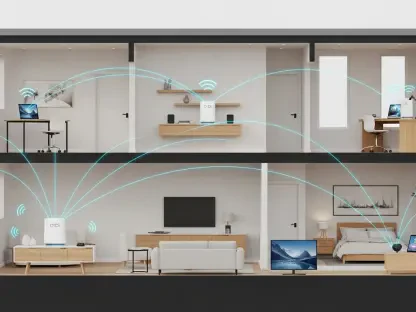In a rapidly evolving technological landscape, a significant development is unfolding under the sea. This innovation extends the capabilities of subsea fiber optics beyond data transmission, transforming them into sophisticated environmental sensing devices. Ciena, a leader in global subsea fiber optics, has ventured into this dual-functionality, offering a revolutionary potential for both telecommunications and environmental science. Leveraging fiber optic cables capable of detecting environmental changes, this technology promises to become a game-changer in monitoring the oceanic environment.
Expanding the Role of Subsea Cables
Multifunctional Infrastructure
Traditionally, subsea fiber optic cables have been primarily utilized for transmitting massive amounts of data across continents. However, recent advancements have positioned these networks as multifunctional infrastructure. By embedding sensors into the cables, they serve as continuous environmental monitors, tracking temperature fluctuations, vibrational changes, acoustic signals, and even chemical alterations in the ocean. This dual utility not only enhances the cable’s value but also addresses a pressing need for monitoring marine ecosystems.
The potential applications of this technology extend far beyond its primary telecommunications purpose. By identifying threats to cable integrity or analyzing marine life activity, such as whale sounds, these enhanced cables promise new commercial and scientific opportunities. This venture into environmental sensing represents a paradigm shift, transforming existing cable networks into rich sources of real-time environmental data. Subsequently, it creates a new revenue stream for cable operators, who can lease access to this data to governmental and scientific entities, fostering a synergetic relationship across sectors.
Addressing Environmental Challenges
By capitalizing on the vast capabilities of fiber optic sensing, the telecommunications industry can significantly contribute to combating environmental challenges. One such challenge is the integrity of these cables; identifying activities threatening their function can prevent costly repairs and service disruptions. Furthermore, the ability to listen to and analyze marine life behaviors offers scientists crucial insights into the health and dynamics of ocean ecosystems. Such insights could lead to more informed conservation strategies, benefiting both operators and environmentalists.
However, the integration of this technology is not without challenges. Regulatory frameworks, privacy concerns, and data ownership issues present significant hurdles. According to industry experts, the technology itself is designed to mitigate privacy concerns since it focuses on environmental activities rather than personal information. Nevertheless, entities responsible for deploying this technology must navigate these challenges carefully to realize its full potential. The benefits, including enhanced cable protection, detailed environmental monitoring, and new scientific discoveries, highlight the significant upside to addressing these challenges.
Technological and Industry Synergies
Industry Collaboration
To fully harness the potential of subsea fiber optic sensing, collaboration across industries becomes vital. The Fiber Optic Sensing Association (FOSA) plays a pivotal role in bridging the telecommunications industry with other sectors, such as public utilities and smart city initiatives. By encouraging partnerships between telecom providers, city planners, and environmental agencies, FOSA aims to promote standardized practices and innovative applications of sensing technology. Such collaboration ensures a broad deployment of subsea sensing, facilitating a comprehensive approach to environmental monitoring.
Telecom providers are not the sole beneficiaries of fiber optic sensing advancements. Public utilities and transportation sectors also stand to gain substantial benefits from integrating these technologies into their infrastructures. By providing real-time data on environmental conditions, fiber optic sensors can enhance infrastructure resilience, improve maintenance strategies, and offer early warning systems for potential environmental threats. This cross-industry approach promises to maximize the utility of fiber optic networks, transforming them into indispensable tools for a wide array of sectors.
Overcoming Hurdles
The journey towards widespread adoption of fiber optic sensing technology is not without its obstacles. Regulatory and ownership complexities present some of the most daunting challenges. While the technology is designed to avoid privacy breaches, the question of data ownership remains a contentious issue. It requires navigating complex legal landscapes to define who owns the data and how it can be utilized. Industry experts emphasize the importance of clear agreements and policies that balance innovation with ethical use.
Efforts to overcome these hurdles are underway, with industry leaders advocating for flexible regulations that encourage innovation while protecting interests. These efforts include developing frameworks that clarify data ownership and usage rights. Additionally, fostering a culture of transparency and collaboration among stakeholders can help address these challenges, promoting widespread adoption. By aligning technological capabilities with clear regulatory structures, fiber optic sensing can become a cornerstone of subsea advancements, enhancing both data transmission capabilities and environmental monitoring precision.
A Glance Toward the Future
In today’s fast-paced world of technology, a significant breakthrough is emerging beneath the ocean’s surface. Advances in subsea fiber optics have taken them beyond just carrying data; they’ve now evolved into advanced tools for sensing environmental changes. Leading the charge in this domain is Ciena, a prominent figure in the global subsea fiber optics industry. They are pioneering a dual-purpose use for these cables that could revolutionize both telecommunications and environmental studies. By harnessing these fiber optic lines, they’re introducing a system capable of detecting subtle shifts in the oceanic environment, paving the way for an innovative approach to monitoring our seas. This technology holds tremendous promise for understanding and safeguarding marine ecosystems, enabling scientists and environmentalists to gain valuable insights into the underwater world. With such capabilities, this development is poised to redefine both ocean monitoring and the broader field of environmental science, representing a true game-changer in understanding our planet.









